| Release List | Coupons | Shop | Reviews | SUBSCRIBE | Forum | DVD Eggs | Video Games | Advertise |
| Reviews & Columns |
|
Reviews DVD TV on DVD Blu-ray International DVDs Theatrical Video Games Features Collector Series DVDs Easter Egg Database Interviews DVD Talk TV DVD Talk Radio Feature Articles Columns Anime Talk DVD Savant Horror DVDs Editor's Blog Silent DVD
|
DVD Talk Forum |
|
|
| Resources |
|
DVD Price Search Customer Service #'s RCE Info Links |
| DVDTalk Info |
|
Review Staff About DVD Talk Advertise Newsletter Subscribe Join DVD Talk Forum DVD Talk Feeds |
 |
The World War II Collection, Vol. 2: Heroes Fight for Freedom
|
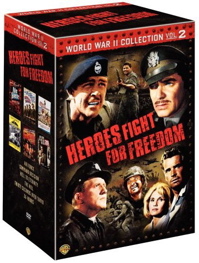
|
Warner DVD Street Date June 5, 2007 59.98 the boxed set Available separately at 19.98 Reviewed by Glenn Erickson |
Just when we thought that quality WW2 war dramas were running thin, Warners comes out with the best set yet, The World War II Collection, Vol. 2: Heroes Fight for Freedom. The selection spans twenty years and two or three major gear changes in how the war was repackaged as entertainment. All of the pictures are winners: two morale-boosters made during the fighting, a belated sideways argument supporting the questionable science of strategic bombardment, a powerful civil rights-era examination of a war hero from a Japanese-American background, a slick 1960's "what-if" spy picture and a protest against the military mindset that sticks a dozen great actors in the desert to scream their heads off. We appreciate the sheer variety in these pictures, as well as the opportunity to finally see Phil Karlson's half-forgotten masterpiece Hell to Eternity.
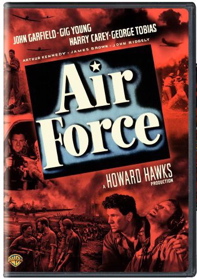
Air Force
1943 / 1:37 flat full frame / 124 min. / available separately at 19.98
Starring John Ridgely, Gig Young, Arthur Kennedy, Charles Drake, Harry Carey, George Tobias, Ward Wood, Ray Montgomery, John Garfield, James Brown
Cinematography James Wong Howe
Art Direction John Hughes
Film Editor George Amy
Original Music Franz Waxman
Written by Dudley Nichols
Produced by Howard Hawks, Hal B. Wallis, Jack L. Warner
Directed by Howard Hawks
The excellent Air Force has been reviewed separately at this URL.
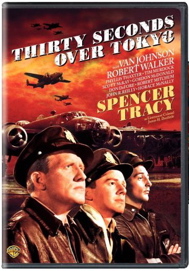
Thirty Seconds Over Tokyo
1944 / 1:37 flat full frame / 138 min. / available separately at 19.98
Starring Van Johnson, Robert Walker, Don DeFore, Robert Mitchum, John R. Reilly, Stephen McNally, Spencer Tracy, Phyllis Thaxter
Cinematography Harold Rosson, Robert Surtees
Special Effects A. Arnold Gillespie
Art Direction Cedric Gibbons, Paul Groesse
Film Editor Frank Sullivan
Original Music Herbert Stothart
Written by Robert Considine, Dalton Trumbo from the book by Major Ted W. Lawson
Produced by Sam Zimbalist
Directed by Mervyn LeRoy
Much more realistic than Air Force yet still wearing its wartime concerns and prejudices on its sleeve, Thirty Seconds Over Tokyo is one of the best remembered war films. The script is partly the work of the soon to be blacklisted Dalton Trumbo, whose main 'subversive' contribution is to suggest that American fighting men were idealists (not that!) hoping that their efforts would bring about a better world. As they prepare for a possible suicide mission, the flyers played by Van Johnson (in perhaps his best role) and newcomer Robert Mitchum express the hope that their kids will grow up free of war's chaos. Then again, the wartime mindset has its limits. When Mitchum turns wistful, he stares out at the ocean and says, "I don't hate Japs. I don't like 'em, but I don't hate 'em -- yet." 1944 America is far from ready to forgive and forget.
Thirty Seconds Over Tokyo is the wartime equivalent of a caper film, a raid planned and carried out in secret by determined specialists. As in a caper, the mission goes wrong almost from the start and our resourceful airmen must improvise 'on the fly.' Spencer Tracy's tough-guy Jimmy Doolittle stands before his men and announces that anybody averse to bombing civilians will be excused without dishonor. Who would dream of doing such a thing? A flyer scrubbed for a simple technicality is crestfallen not to be allowed to take part in the raid. Our 'hero' lies to his superiors about the questionable condition of his airplane, fearful that he he'll be scrubbed too. That's the appeal of a male group banding together to do a dangerous job .... men use such challenges to define themselves.
The film's account of the raid is fairly accurate, especially when compared to the bald falsehoods floated in pictures like Air Force and Wake Island. Only a few issues are stretched. It doesn't seem likely that the flyers' wives would be allowed to follow them from camp to camp for such a secret mission (but it may be true in this case; I haven't read the book). Nowhere is the raid acknowledged as a morale-boosting stunt to stave off American despair in a year the top brass knew would be mainly a bunch of bad headlines. Sixteen light B-25 bombers carry only a few tons of bombs, and the actual damage done to Japanese targets isn't all that significant. Thirty Seconds Over Tokyo shows single bombs blowing entire factories sky high and lighting half a city on fire, a filmic exaggeration that gives the raid a delayed morale kick, two years later. To its credit, the movie avoids the outright hokum of many other films made during the war. The pilots do not repel fantasy attacks by Zero fighters. When they reach China, they don't find a beautiful Eurasian princess in need of passionate rescue. 2
Air Force big cheese Hap Arnold and raid leader Jimmy Doolittle were advisors on the film, which makes it all the more pleasing that the fliers are shown as cocky individuals and not representatives of a 'perfect' Army Air Corps. Yes, we see plenty of glad-handing demonstrating that the Army and Navy are all buddies where it counts. But our hero has a clever plan to smuggle cartons of cigarettes along in his bomber, and use the profits to offset his gambling losses. Compare that to Gus Grissom 'screwing the pooch' when he gets caught with his pockets full of souvenir toys after his Mercury mission. Perhaps Tokyo's best timed moment is on the aircraft carrier when Lawson and a clerk are caught off-guard by an unplanned contact with the enemy. They stare at each other in disbelief before bolting to their battle stations. Out of bland normalcy, the big raid has begun!
The raid is meticulously filmed, and because earlier scenes show actual aircraft doing wild short-hop takeoffs, A. Arnold Gillespie's effects fool many into thinking they're looking at real planes and exploding factories instead of miniatures. 1 Some enormous Tokyo-scape models are only seen for a second or two. Mattes turn the Chinese coast into a rather optimized fairytale landscape, but the realism of the flight and the crash is commendable.
The movie is handsomely cast, with Van Johnson again representing America's best. Barely seen in The Human Comedy, Robert Mitchum makes a solid impression as a straight-talking westerner, the kind of dependable buddy anybody would want on their side. Crinkly-eyed Phyllis Thaxter is the slightly glamorized dream wife, the kind every soldier wanted to settle down with, after a few weeks with Rita Hayworth, of course. Thaxter's blonde gal friend is Jacqueline White, who later appeared in Richard Fleischer's film noir The Narrow Margin.
Thirty Seconds Over Tokyo uses the fact that Lt. Lawson lost a leg to provide human interest in the last few reels after the raid ... how will he tell his wife? When Lawson falls asleep during the amputation operation, we see a wickedly creepy flashback of him talking on the phone as a large tree is sawed down in the background! The pilot is determined to hide his missing leg and the hairline scar on his forehead from his wife. In 1944 he surely saw many boys coming back in far worse condition, so his sensitivity about the leg seems ungallant. But those were different times. 3
The DVD of Thirty Seconds Over Tokyo looks great; this title has always fared well on home video. Of the added short subjects (see below) A Lady Fights Back is the most interesting; it anthropomorphoses a civilian ship that sees duty during the war.
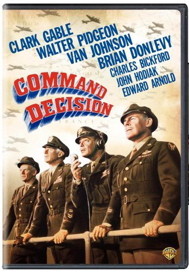
Command Decision
1949 / 1:37 flat full frame / 111 min. / available separately at 19.98
Starring Clark Gable, Walter Pidgeon, Van Johnson, Brian Donlevy, Charles Bickford, John Hodiak, Edward Arnold, Marshall Thompson, Richard Quine, Cameron Mitchell
Cinematography Harold Rosson
Art Direction Cedric Gibbons, Urie McCleary
Film Editor Harold F. Kress
Original Music Miklos Rozsa
Written by George Froeschel, William R. Laidlaw from the play by William Wister Haines
Produced by Sidney Franklin, Gottfried Reinhardt
Directed by Sam Wood
Hollywood began to revisit combat-related themes after a couple of years of socially conscious readjustment movies like The Best Years of Our Lives and Till the End of Time. Like the later Above and Beyond, which told the story of Hiroshima by concentrating on the tough problems of the pilot that dropped the bomb, Command Decision examines the new military science of strategic bombing in a way that carefully limits the issues in the debate. Originally a stage play, the show is neatly reasoned out to gain viewer approval for mass aerial bombardment. The idea that civilians are dying under these bombardments is never even raised.
The post-war creation of the Air Force and the consolidation of special war departments resulted in a giant corporation-like Pentagon structure, a permanent war government. As explained by Robert McNamara in The Fog of War, the fates of civilians to be bombed took low priority against a growing Air Force that needed to establish its policies as central to any war effort. Command Decision is not about the late-war 'experiments' in mass aerial bombardment, in which a German city might be chosen to be annihilated just so that experts could quantify the efficacy of a particular bombing technique. We're instead given a do-or-die secret program called Operation Stitch. Its purpose is to knock out production of new Nazi jet pursuit planes that, if allowed to progress, would give Hitler supremacy in the air and turn the tide of the war.
Everything I've read about the jet planes says that they came too late to help the Nazi cause; Russian troops had already disrupted supply lines and the Germans couldn't have gotten very many into the air before being completely overrun. Command Decision tells us that Strategic Bombing planners like Clark Gable's dashing General Dennis are America's misunderstood heroes. Dennis must send hundreds of young fliers on cruel missions (40 - 50 planes lost in a single raid), and can't explain why the sacrifice is necessary because the existence of the Nazi jets is top secret. Charles Bickford's newsman thinks Dennis is a maniac and part of his own forces are near mutiny; only the genial dog-robber Sgt. Immanuel Evans (Van Johnson) still thinks Dennis is an okay guy.
We side with Dennis because he's up against the play's real bad guys, the bean counters and glad-handing politicians that will support him only when losses are minimal and photo ops are available with victorious young fliers. His superior General Kane has been playing footsie with the nabobs back in Washington and is beginning to act like them: hobnobbing with local royalty takes precedence over looking after the combat missions. But Command Decision tells us that Kane's diplomatic lizard and Dennis' hard-nosed warrior are both indispensable in the new age of (almost) push button warfare.
Even more importantly, the movie drives home the message that our business as citizens is to shut our traps and let the military "do its job." That means forking over billions without question, along with the lives of however many young soldiers that need to be spent. With Clark Gable telling us it's necessary, it's a persuasive argument.
The play pretends that consensus can be found on these issues. Even Charles Bickford's cynical correspondent gives General Kane his full cooperation, after he knows the facts. Dennis sends him into the next room with the whole top-secret folder on Operation Stitch (pardon me while I fall down laughing) and the free press steps dutifully into line.
All the actors are good, with Gable and Pidgeon especially good dishing out long author's position speeches to bracket the play's central argument. When faced with new responsibilities Brian Donlevy's clueless General stops acting like a fool and buckles down to work. John Hodiak is a daring flyer and Dennis' best pal; he shouldn't have talked about buying that farm back home. Edward Arnold is the Congressional Jerk, Marshall Thompson a likeable kid flier and Cameron Mitchell a bombardier who makes a painful mistake. Ray Collins, Warner Anderson and John McIntire are excellent in smaller parts. Sadly, the talented John Ridgely from Air Force has only a tiny bit.
Command Decision also looks fine in a near-perfect transfer; the show takes place mostly in a few dank interior sets. MGM's special effects are limited to one spectacularly unsuccessful emergency landing.
Both short subject extras are good. The Souvenirs of Death piece is about a Mauser pistol brought back from Germany that becomes a threat to all that possess it. Tex Avery's wonderful surreal cartoon King Size Canary is a beautifully subversive intellectual statement (I kid you not) about the post-nuclear 'imbalance of the universe'. A starving cat, a mouse and a bulldog named "Atom" (hmmmm...) grow to Amazing Colossal proportions by glorping an over-the-counter elixir. Whether a statement on consumerism run mad, or a treatise that the atomic world is shrinking toward an apocalypse, this is true art!
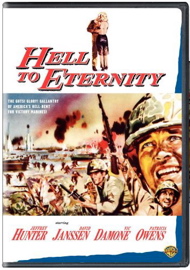
Hell to Eternity
1960 / 1:78 anamorphic widescreen / 132 min. / available separately at 19.98
Starring Jeffrey Hunter, David Janssen, Vic Damone, Patricia Owens, Sessue Hayakawa, Miiko Taka, Tsuru Aoki, Richard Eyer, John Larch
Cinematography Burnett Guffey
Art Direction Dave Milton
Film Editor Roy V. Livingston, George White
Original Music Leith Stevens
Written by Gil Doud, Walter Roeber Schmidt, Ted Sherdeman
Produced by Frank King, Herman King, Maurice King, Irving H. Levin
Directed by Phil Karlson
The surprise of the boxed set, Hell to Eternity is yet another superior film by the unappreciated director Phil Karlson, who should be more highly rated for hard-hitting titles like Kansas City Confidential, 99 River Street, Tight Spot, Five Against the House, The Phenix City Story and The Brothers Rico.
Hell to Eternity is particularly surprising because of its take on the Japanese-American internment problem, which the PC version of history claims wasn't 'discovered' until the liberal 1970s. Karlson's picture is pretty coarse -- its scenes of rowdy, horny Marines on the prowl in Honolulu are way out of line for a 1960 movie -- and yet it makes a reasonably fair statement about the relocation of California's Japanese Americans to places like Manzanar.
Hell to Eternity makes one telling revision to history by not identifying Guy Gabaldon as an East-L.A. Latino; as personified by Jeff Hunter he comes off as an all-American hero, albeit a tough teenager with skull tattoos on his arms. Director Karlson quickly establishes Guy's need for love and compassion, which he finds with his adoptive Japanese family. The harmonious bilingual relationship comes off as uniquely American and definitely positive.
Interestingly, when war breaks out the Japanese-American boys are just as eager to smack down the Japanese Empire as anyone. They identify themselves as Americans, and it is only prejudice that causes fights to break out, simply because Guy is seen with his adopted sister Ester (Miiko Taka of Sayonara fame). Not quite as convincing is the family's understanding attitude toward their imprisonment in the equivalent of a benign concentration camp. Mama Une is seen in a Manzanar hut, which has pleasant curtains on the windows. Real Manzanar lodgings were communal and severe. But where else in the culture of 1960 was Manzanar even acknowledged?
Guy's induction into the Marines kicks the film into the war genre implied by the title. Guy has learned slick fighting moves from his adoptive brothers. His rough upbringing in East L.A. gives him the edge at separating a taxi driver from some booze, and corralling some likely broads for 'action.' Movies about G.I.s made around this time tended to soft-pedal the sleaze factor when soldiers went whoring, but Hell to Eternity does everything but throw nudity at us. The boys get stoned and are elated to find out that one of their consorts is a stripper. The normally stiff Patricia Owens gets down to basics and is seen taking side trips to the bedroom with Guy. The sequence ends making a match cut between Guy unfastening Owens' bra strap (see cover illustration) and cannons firing on Saipan. This is hot stuff for 1960 and a lot sexier than most new pictures.
On Saipan we're treated to some large-scale Marine action, a bloody banzai charge and various violent battles. David Janssen and Vic Damone are good as Guy's buddies in the corps, and an agonizing combat death is the catalyst that turns Guy into a stone killer, sneaking out on his own to ambush and slaughter enemy troops. He finally turns to the side of the angels after witnessing women and children throwing themselves over high cliffs. As is typical of Phil Karlson, he doesn't shirk from showing all of this in shocking detail; check out the still-searing Phenix City Story sometime.
The rather slow conclusion shows the action that won Gabaldon all the medals. He captures 800 Japanese troops single-handed by convincing a general (Sessue Hayakawa) that surrender is better than more pointless carnage. Gabaldon's websites (he died in 2006) give us a picture of a Marine who never turned away from the 'slaughter Japs' mentality, but Hell to Eternity ends with a strong feeling of integrity.
Among the cast is a very young George Takei, making good before his Star Trek years.
The DVD of Hell to Eternity is a great move for Warner Home Video, a quality picture from their Allied Artists library that's been ignored for quite a while. The enhanced B&W image makes Burnett Guffey's images look great. The detail is so sharp, we can see a highway and auto traffic in the background behind a Saipan battle zone!
The disc has no extras, only some trailers of '1960s War Movies.'
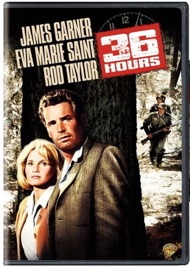
36 Hours
1965 / 2:35 anamorphic widescreen / 115 min. / available separately at 19.98
Starring James Garner, Eva Marie Saint, Rod Taylor, Werner Peters, John Banner
Cinematography Philip H. Lathrop
Art Direction Edward Carfagno, George W. Davis
Film Editor Adrienne Fazan
Original Music Dimitri Tiomkin
Written by George Seaton, Carl K. Hittleman, Luis H. Vance from a story by Roald Dahl
Produced by William Perlberg
Directed by George Seaton
Released in 1965, 36 Hours is among the last batch of studio pictures produced in B&W. The oddball story would appear to have been spawned by author Roald Dahl brainstorming on weird wartime spy pictures like The Man Who Never Was and I Was Monty's Double. In this case the mix seems to have been influenced by Philip K. Dick! The story has similarities to I Can Remember it For You Wholesale, right down to the patsy hero being given a 'wife' who is really a sinister babysitter.
Unfortunately, 36 Hours is too linear in execution to fully exploit its exciting concept. It eventually forgets what kind of movie it is and re-boots as a limp escape film. But it certainly rates points for trying to be different.
Nothing is quite as sad as a great idea written and directed below its potential. George Seaton and James Garner must have sold the high-concept 36 Hours to MGM because it would be cheap to produce. The imaginative story combines Allies vs. Nazis thrills with something akin to The Sting: Will poor confused Major Pike see through the elaborate con, or will a sneaky enemy trick turn the tide of the war? Unfortunately, the dull George Seaton almost kills the story by pitching it at a level a 12 year-old could figure out.
36 Hours assumes at all times that everything that happens needs to be explained before the fact. We're never allowed to identify with Major Pike directly because we're told exactly what's going on while he's still asleep, being prepared for the charade. True, a real puzzle picture like Memento would probably sail over the heads of an average 1965 audience; quizzlers like Curtis Harrington's 1967 Games threw most viewers. American audiences also had little patience with the mysterious Seconds, another 'far-out' mystery that asked viewers to pay attention and question the reality presented on screen. 36 Hours would have been a knockout if we spent the first afternoon at the hospital experiencing Pike's disorientation along with him. Then, as his mood slowly turned to paranoia, the big jolt could be revealed.
With certain exceptions (Miracle on 34th Street) George Seaton made so-so films that could have been much better. Once every ten years or so, he hit the jackpot with a giant hit like Airport. The 36 Hours script doesn't allow us to work on the puzzle ourselves. We're told why Pike hears only the rigged radio station, and how they monkey with his eyesight. There's no room for accident or improvisation. When Pike cuts his hand in the first scene, it's ludicrously obvious that a crucial plot point is being set up. Spoilers are impossible in 36 Hours as the script itself does all the spoiling. The only real suspense is wondering when the Germans posing as Americans will screw up. Rod Taylor has a tough illusion to maintain that the script barely touches. What if one of his 'actors' doesn't know what the Brooklyn Dodgers are?
Roughly the first half of the movie is fun anyway, as the bold concept invigorates the brain cells like a good Twilight Zone or Alfred Hitchcock Presents. Then Seaton undercuts his own story. Eva Marie Saint comes in with an unnecessary, poorly integrated concentration camp subplot. Since the devious medico Rod Taylor needs to become one of those basically 'good' Nazis, we're given a cardboard sniveling Gestapo to serve as a villain.
James Garner is terrific. He animates and elevates the material every step of the way, overcoming many of the toughest plot twists with a bewildered look or a sidelong glance. MGM apparently didn't have much faith in this 'far out' scenario, for 36 Hours spends a completely superfluous final 30 minutes watching Garner attempt an overland escape to Switzerland. This part of the film isn't helped when actor John Banner shows up, reminding us of Hogan's Heroes. Interestingly, we earlier see a truck driving to the secret German compound through a landscape that's a dead ringer for the green valley in The Great Escape. They should have added a motorcyclist in a torn sweatshirt, heading the other way!
After all that, it might sound inconsistent to say that 36 Hours is an entertaining show, but it is. My reservations are simply that it held the promise of being much, much better.
36 Hours is a good B&W transfer that looks a little weird in some nighttime shots, as if the lens optics had grief with bright lights -- certain objects in the background break up optically now and then. Whatever it is, it's an original camera flaw and not part of Warners' clean encoding. A trailer is the disc's only extra.
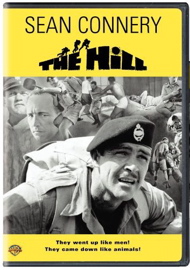
The Hill
1965 / 1:78 anamorphic widescreen / 123 min. / available separately at 19.98
Starring Sean Connery, Ossie Davis, Jack Watson, Roy Kinnear, Harry Andrews, Ian Hendry, Ian Bannen
Cinematography Oswald Morris
Art Direction Herbert Smith
Film Editor Thelma Connell
Written by Sidney Lumet from the play by Ray Rigby, R.S. Allen
Produced by Kenneth Hyman
Directed by Sidney Lumet
Just about the only unlikable thing about this war movie collection is its sub-title Heroes Fight for Freedom, which puts me in a smart aleck mood -- what is Warners trying to do, sell some extra copies to the Bush family? But the real sarcasm comes when one tries to apply that slogan to this hellishly rebellious 1965 Sidney Lumet film, one of the roughest, most credibly brutal dramas ever about the downside of army discipline. Ray Rigby and R.S. Allen's play has little positive to say in its story of venality and corruption in a Middle Eastern British soldier's prison. It's chock full of powerful performances and toplined by Sean Connery in one of his very best roles.
The Hill is a darn-near unforgettable picture, a tightly-written play about a lot of desperate men under unbearable pressure. Anybody who's encountered maddening injustice will recognize the abusive chemistry of male authority. In this sealed prison system the guards can get away with most anything because their charges already have few rights. Treating the men roughly shows them who is boss but also leads to grievous excesses, cowardly cover-ups and ruptures in the rotten chain of command. It's like Washington, D.C, or anybody's daily workplace, except guys are getting killed.
The play sketches vivid characters and turns a blowtorch on touchy subjects like racism. The superb Ossie Davis (The Scalphunters) is insolent or jolly as the situation dictates, and when he finally cracks up, practically takes over the movie. Weasely Roy Kinnear is an instantly recognizable type while Connery cuts a fine figure as a bitter man on the verge of revolt. He's much more alive and insistent here than he is in a similar role in The Molly Maguires, and he too gets a full workout ... I've never seen Connery wailing in despair like this, totally out of control.
A big share of the credit for The Hill's dramatic tension and electrifying performances must go to director Sidney Lumet. With cameraman Oswald Morris he finds an extremely effective visual style to go with the gritty theatrics. Hand-held camera work was never better, and some crane shots over the torturous punishment hill are just as effective. The Hill confronts us with men barking orders, and just as often screaming into the camera, and never makes a false dramatic step or becomes shrill. The acting is uniformly flawless, from a cast of 'tough guy' performers often wasted in inconsequential action films.
The prison camp really is hell. The 'good' Staff officer takes a demoralized prisoner aside and starts to talk about a previous convict who was a homosexual 'nancy.' We realize there's no hope for these men, as even the benign guard may be a different kind of predator.
The disc of The Hill benefits greatly from a handsome enhanced transfer that eliminates the excessive grain and bad contrast of earlier video versions. Even more welcome is the English subtitle option, which finally allows us Yanks to understand what everyone is saying ... when these men all start screaming in their various accents and dialects, we often need help to follow.
A featurette about the making of the film in Almería is the main extra, with trailers for The Hill and two others.
Warners' The World War II Collection, Vol. 2: Heroes Fight for Freedom finds six very different war pictures that show how much the war film changed from the 40s to the 60s -- films that all stand on their own as distinctive entertainments. It's one of the best Warner boxed sets this year.
On a scale of Excellent, Good, Fair, and Poor,
|
Thirty Seconds Over Tokyo rates:
Movie: Excellent Video: Excellent Sound: Excellent Supplements: Short subjects Movie Pests, A Lady Fights Back, cartoon Bear Raid Warden, trailer |
Command Decision rates:
Movie: Very Good Video: Excellent Sound: Excellent Supplements: short subject Souvenirs of Death, cartoon King Size Canary, trailer |
|
Hell to Eternity rates:
Movie: Excellent Video: Excellent Sound: Excellent Supplements: trailer |
36 Hours rates:
Movie: Very Good Video: Very Good + Sound: Excellent Supplements: trailer |
|
The Hill rates:
Movie: Excellent Video: Excellent Sound: Excellent Supplements: 1965 featurette The Sun ... the Sand ... The Hill |
Air Force rates:
Movie: Excellent Video: Excellent Sound: Excellent Supplements: Sort subject Women at War, cartoons Fifth Column Mouse and Scrap Happy Daffy; radio adaptation, Trailer |
Packaging: Five keep cases in card sleeve
Reviewed: June 8, 2007
Footnotes:
1. This was Oscar-winning effects whiz A.D. Flowers' first film. For Spielberg's 1941 he reconstructed the 'old fashioned' method of flying model planes on wires, improving on the Thirty Seconds designs.
Return
2. The hideous truth about the modern macho action movie Pearl Harbor is that it sees nothing wrong with repeating the old 'morale building' fantasies -- its Doolittle raiders 'kick ass' against the Japanese when they land in China. Embarrassed by their own jingoistic excesses, the studios later cut many 1940s war films severely, like Wake Island. And the kill-crazy, racist Gung Ho! hasn't been seen in years.
Return
3. A welcome 'whattaya know?' response from correspondent Avie Hern, 6.12.07: Glenn: Enjoyed the reviews of the Warner's war-film set. Regarding Thirty Seconds Over Tokyo: The scars on Van Johnson's face weren't make-up or, rather, what make-up was there didn't create the scars, but were meant to minimize them. Just before the film was to begin shooting, Johnson was in a serious car wreck that took off part of his skull and nearly killed him. MGM wanted to re-cast, but Spencer Tracy insisted that Johnson, of whom he was very fond, be allowed to recuperate, so the film shot around his scenes until he was well enough to rejoin the cast. If you look at The Caine Mutiny, the scars all 'round the top of Johnson's head are evident in all their gory glory. --- Avie
Return
Reviews on the Savant main site have additional credits information and are more likely to be updated and annotated with reader input and graphics.
| New Review: |
|
|
| Special Offer |
|
| Home | Release List | Coupons | Shop | Reviews | Forum | Video Games | Price Search | Advertise |






